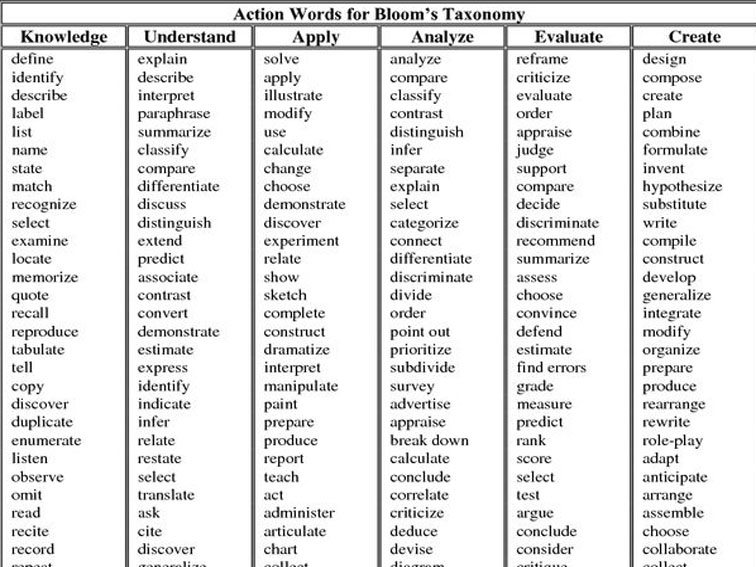Establishing student engagement can be helped by simply telling students where the lesson is going. We tell students this through creating and explaining our objectives. Objectives always begin with an action word. Below is a resource for selecting action words from Bloom's Taxonomy.
 |
| Image was taken from teach thought.com. http://www.teachthought.com/critical-thinking/blooms-taxonomy/14-brilliant-blooms-taxonomy-posters-for-teachers/
If students are given clear and measurable learning objectives, they understand what they really need to focus on.
The portion of this week's reading from Newcomb and company covered techniques for group teaching. Teaching in groups can be very effective when done correctly. One of the types of group facilitation is discussion. In order for discussion to be effective, the educator must determine what avenue they should take. Class discussion works well for large groups as long as students aren't timid. Usually a couple students take charge and are the only ones to contribute to the discussion. Teachers can also use buzz groups or pair share to facilitate discussion in smaller groups. When students are grouped into small groups they feel more of a need to contribute. This promotes everyone to share their thoughts. After the use of smaller groupings, the facilitator should have each group share out with the rest of the class.
Image was taken from global-english.com.
http://www.global-english.com/news/tips-for-tefl-discussion-classes/
As an educator I believe that discussion through small groups leads to the most growth. I am not opposed to trying larger group activities because of my inexperience in the classroom. However, throughout high school, I have seen many large group activities fall right on their face. I look forward to experimenting with these different techniques over the next year, especially during my semester of student teaching.
References: Whittington, M.S. (2005). Writing objectives in secondary agriculture courses that challenge students to think. Agriculture Education Magazine. Retrieved from http://www.naae.org/profdevelopment/magazine/archive_issues/Volume77/v77i5.pdf Newcomb, L.H., McCracken, J.D., Warmbrod, J.R., & Whittington, M.S. (1993). Methods of teaching agriculture. Upper Saddle River, New Jersey: Pearson Prentice Hall. Groseta, K.J. & Myers, B.E. (2006). Using cooperative learning in formal and nonformal education. Retrieved from https://edis.ifas.ufl.edu/pdffiles/WC/WC06200.pdf |
Matt, I have had those bad teachers, too. One thing I love about teaching ag, is that we can't do that and our students won't be forced to do that because we are so hands on. I also used the Bloom's Taxonomy sheet in my blog. Great minds think alike!
ReplyDeleteMatt,
ReplyDeleteWhat will Students say about your classes on a daily basis?
Dr. Foster
"Excellence is not an act, but a habit. Success is a result of our daily routines."
Dr. Foster,
ReplyDeleteStudents will love their Ag courses with all of the hands-on experiential learning. No boring lectures here.
Matt
I agree lecture is overused/abused but has its place and it scares me how easy it might be to fall into it
ReplyDeleteI really like your point about simply telling students where it is going. I cannot agree more. I hate when i don't know what is expected of me. not just in assignments but also in total outcome. I think it is great to have students working in small groups so everyone can get a chance to contribute. I think the challenge is getting that to work
ReplyDelete